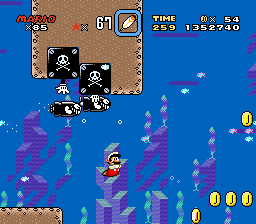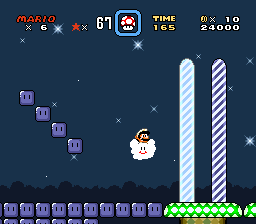

Super Mario World (1991 - SNES) 
Super Mario World is a difficult game for me to review, because it's a game I like, but I don't feel very strongly about it. I don't hold it in as high of a regard as I do Super Mario Bros. 3, which, in many ways, it feels like an easier version of, except with Yoshi instead of the special suits.
It does have some decent stage design, particularly the later fortresses and castles, and the Special Worlds, but much of it goes by with little effort. Since this was the Super NES's flagship title, it's appropriate to comment on the graphics, which are bright and colorful, but lacking in detail. The final boss fight with Bowser, which makes heavy use of the system's Mode 7 function, is at least memorable if not super-difficult.
Another reason I've never found this game as enjoyable as SMB3 is that I don't like Mario's cape flying controls as much as I did his raccoon tail controls. The cape is awkward to use, and that's probably why it's never truly utilized in an engaging way - no stages that absolutely require you to fly to complete them. Yet, even with their unintutive nature, they can be easily used to bypass stages that are tough to traverse on foot. (For the first time in my life, I finally beat that forest Special World without flying, as I had to for an RA achievement.)
I realize this game has its fans who would probably be none too happy with this review, but considering that Yoshi's Island, the game's sequel, took every issue I've outlined here and improved greatly upon them, it would seem that even the developers knew that Super Mario World wasn't quite the game they had intended it to be.
3.5/5







